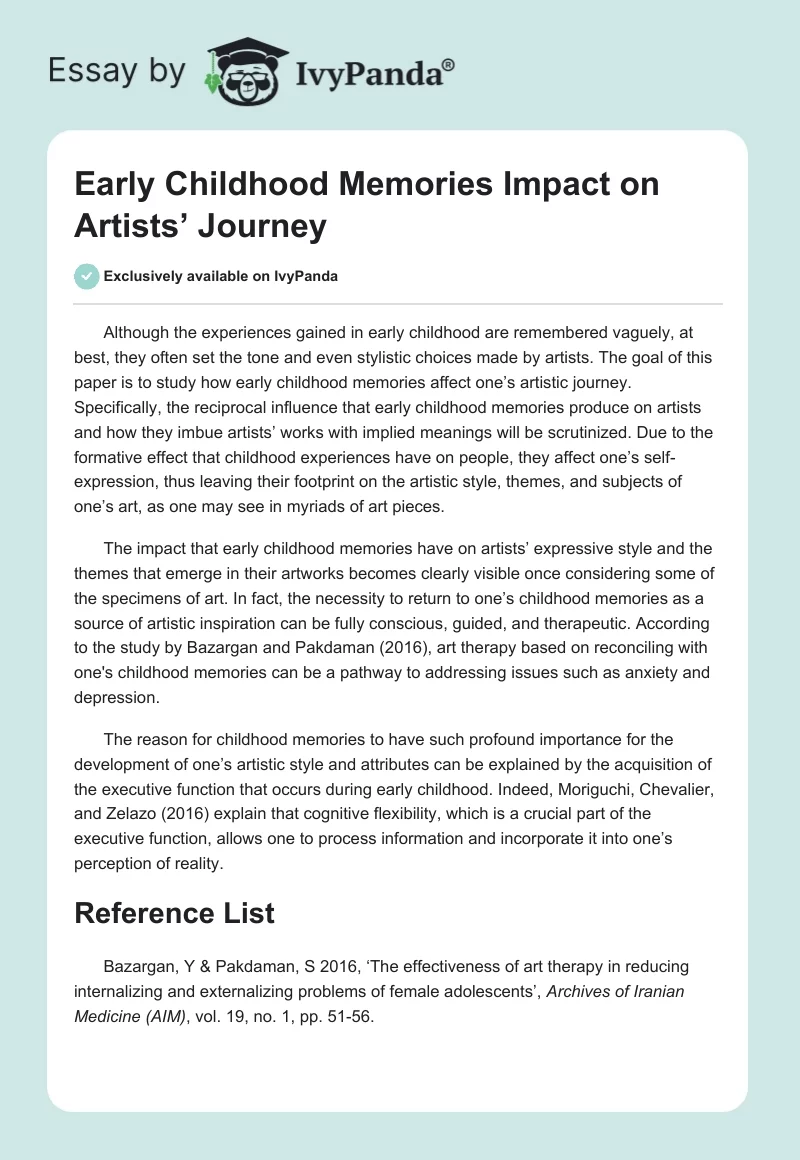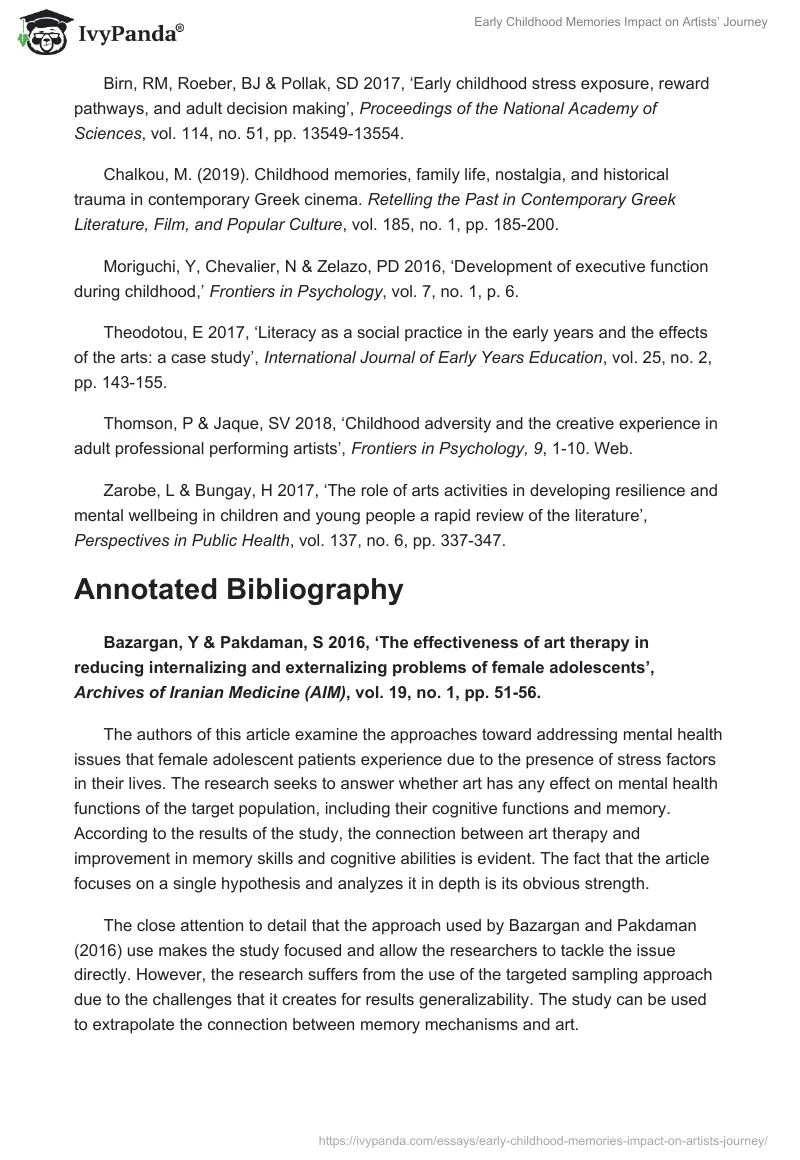Although the experiences gained in early childhood are remembered vaguely, at best, they often set the tone and even stylistic choices made by artists. The goal of this paper is to study how early childhood memories affect one’s artistic journey. Specifically, the reciprocal influence that early childhood memories produce on artists and how they imbue artists’ works with implied meanings will be scrutinized. Due to the formative effect that childhood experiences have on people, they affect one’s self-expression, thus leaving their footprint on the artistic style, themes, and subjects of one’s art, as one may see in myriads of art pieces.
The impact that early childhood memories have on artists’ expressive style and the themes that emerge in their artworks becomes clearly visible once considering some of the specimens of art. In fact, the necessity to return to one’s childhood memories as a source of artistic inspiration can be fully conscious, guided, and therapeutic. According to the study by Bazargan and Pakdaman (2016), art therapy based on reconciling with one’s childhood memories can be a pathway to addressing issues such as anxiety and depression.
The reason for childhood memories to have such profound importance for the development of one’s artistic style and attributes can be explained by the acquisition of the executive function that occurs during early childhood. Indeed, Moriguchi, Chevalier, and Zelazo (2016) explain that cognitive flexibility, which is a crucial part of the executive function, allows one to process information and incorporate it into one’s perception of reality.
Annotated Bibliography
Bazargan, Y & Pakdaman, S 2016, ‘The effectiveness of art therapy in reducing internalizing and externalizing problems of female adolescents’, Archives of Iranian Medicine (AIM), vol. 19, no. 1, pp. 51-56.
The authors of this article examine the approaches toward addressing mental health issues that female adolescent patients experience due to the presence of stress factors in their lives. The research seeks to answer whether art has any effect on mental health functions of the target population, including their cognitive functions and memory. According to the results of the study, the connection between art therapy and improvement in memory skills and cognitive abilities is evident. The fact that the article focuses on a single hypothesis and analyzes it in depth is its obvious strength.
The close attention to detail that the approach used by Bazargan and Pakdaman (2016) use makes the study focused and allow the researchers to tackle the issue directly. However, the research suffers from the use of the targeted sampling approach due to the challenges that it creates for results generalizability. The study can be used to extrapolate the connection between memory mechanisms and art.
Birn, RM, Roeber, BJ & Pollak, SD 2017, ‘Early childhood stress exposure, reward pathways, and adult decision making’, Proceedings of the National Academy of Sciences, vol. 114, no. 51, pp. 13549-13554.
The research provides a general account of how memories shape one’s journey as an adult. According to the results of the study, even the memories that may seem to relate to the childhood that is far too early to be remembered, they remain deep-seated motives for choices in adulthood. Therefore, the article provides the foil for the discussion of how the issues experienced in childhood affect one’s adult life.
Chalkou, M. (2019). Childhood memories, family life, nostalgia, and historical trauma in contemporary Greek cinema. Retelling the Past in Contemporary Greek Literature, Film, and Popular Culture, vol. 185, no. 1, pp. 185-200.
Being another research that considers the effects of childhood memories on one’s life as an adult, the study covers the impact that painful early childhood experiences have on the creation of movies as an art form. According to the study, the use of the coming-of-age-story trope, the authors are trying to cope with their negative childhood experiences and manage the memories thereof, which often translate into the collective trauma. Since the paper views art through the lens of childhood experiences and the related memories, it fits the general narrative of childhood memories shaping the artistic development of adults perfectly. Therefore, it can be used to support the key claims of this paper.
Moriguchi, Y, Chevalier, N & Zelazo, PD 2016, ‘Development of executive function during childhood,’ Frontiers in Psychology, vol. 7, no. 1, p. 6.
Being a component of the phenomenon known as the executive function, memory provides one with an opportunity to gain experience and infer important life lessons from them. Therefore, to study the effects that early childhood memories have on artists, one will need to consider the influence that they have on adults, in general. In their research, Moriguchi, Chevalier, and Zelazo consider the mechanisms of developing the executive function as the platform for gaining critical memory skills. The research proves that the memories acquired during childhood shape one’s further philosophy and values extensively.
Theodotou, E 2017, ‘Literacy as a social practice in the early years and the effects of the arts: a case study’, International Journal of Early Years Education, vol. 25, no. 2, pp. 143-155.
In her study, Theodotou analyzes the effects that arts have on one’s early childhood development and especially on shaping one’s literacy. The research results indicate that the link between literacy and art is explicitly direct. The paper by Theodotou shows that the connection between art and early childhood memories is reciprocal since literacy provides the basis for social practices and especially the development of communication skills. Therefore, the authors infer that early childhood memories may affect one’s artistic expression significantly. The article can be used to prove that early childhood literacy and art are interconnected.
Thomson, P & Jaque, SV 2018, ‘Childhood adversity and the creative experience in adult professional performing artists’, Frontiers in Psychology, 9, 1-10. Web.
The paper by Thomson and Jaque (2018) points to the need to effects that negative childhood memories have on one’s artistic potential. The paper argues that high levels of childhood adversity experienced by artists in the past may cause them to develop issues such as internalized shame. Similarly, anxiety problems may be observed in the artists that were exposed to violence and abuse as children. The key strength of the research comes from its ability to address several mental health issues in artists simultaneously. However, the fact that the sample contains inherent biases preventing the study results from gaining enough generalizability is its weakness.
Zarobe, L & Bungay, H 2017, ‘The role of arts activities in developing resilience and mental wellbeing in children and young people a rapid review of the literature’, Perspectives in Public Health, vol. 137, no. 6, pp. 337-347.
The research examines the concept of childhood and the part that art plays in it. Therefore, important information about the factors that shape one’s artistic development can be drawn from it. The study will provide the background for this paper as the insightful exploration of artistic expression as the means of coping with one’s emotional issues.


